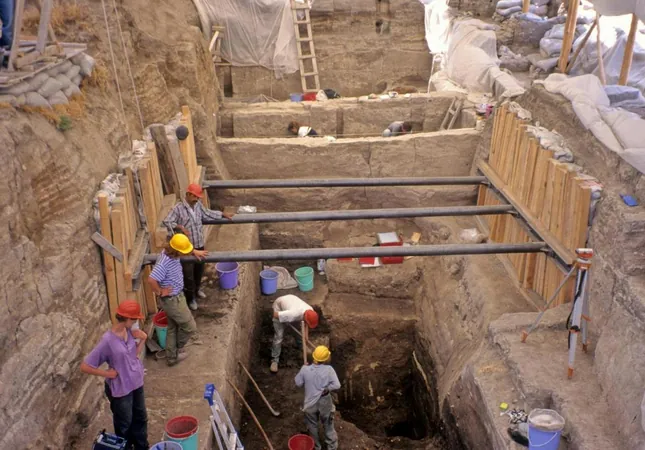
How the Layout of Ancient Cities Helped Combat Diseases and Shaped Civilizations
2025-01-03
Author: Jia
Have you ever wondered how the world's oldest cities managed to survive diseases that plagued early civilizations? Recent research sheds light on the fascinating evolution of urban planning which not only fostered growth but also helped avoid catastrophic outbreaks.
For years, scientists have attributed the fall of early urban centers to factors like climate change, overpopulation, and social turmoil. However, a new contender has emerged: disease. As early humans lived in close proximity to animals, zoonotic diseases—those that jump from animals to humans—thrived. Historical patterns indicate that these outbreaks likely contributed to the abandonment of dense settlements, prompting later generations to rethink their living arrangements to mitigate health risks.
The Case of Çatalhöyük: A Tightly Packed Heritage
Located in what is now Turkey, Çatalhöyük is considered the world’s oldest farming village, dating back over 9,000 years. This ancient settlement was characterized by its remarkable density, with mud-brick houses constructed so closely that residents accessed them through ladders leading to trapdoors on their rooftops. Living conditions were hygienic by ancient standards; houses were meticulously maintained, and families even buried their ancestors underneath the floors.
However, around 6000 BCE, something caused this bustling community to suddenly disperse. Archaeological evidence suggests that the close living quarters may have been breeding grounds for diseases, as human remains were found alongside animal bones, hinting at the transmission of various infections. Notably, ancient DNA analysis reveals the presence of tuberculosis and salmonella dating back millennia. With growing evidence of zoonotic diseases, it’s plausible that the inhabitants of Çatalhöyük reached a tipping point where the dangers of congestion began to outweigh the benefits.
A Strategic Shift at Nebelivka
Fast forward to around 4000 BCE, and impressive urban populations reemerged in the Trypillia culture, particularly in settlements like Nebelivka and Maidanetske in Ukraine. These mega-settlements showcased a radically different plan than their predecessors: houses were spaced out in a circular layout, creating distinct neighborhoods, each with its communal assembly house.
In collaboration with archaeologists, researchers—including Simon Carrignon and the cultural scholar Mike O’Brien—used simulations to analyze how this innovative layout may have curbed disease spread. Their findings were illuminating: infrequent interactions between different neighborhoods significantly reduced the risk of foodborne disease outbreaks.
While the residents may not have consciously designed their village to combat disease, ancient human instincts likely played a role. Frequent cleaning and periodic controlled burns for pest control suggest a practical understanding of health and hygiene.
The Evolution of Urban Design and Disease Management
Despite these advancements, the history of cities is also marked by the relentless evolution of diseases. As infections adapted to spread more effectively—some via airborne means or through vectors like fleas and rats—urban centers like the Trypillia settlements faced new challenges. By 3000 BCE, they too were abandoned, with theories suggesting that burgeoning diseases, including those precursors to modern plagues, contributed to their downfall.
As civilization progressed, the first urban centers in Mesopotamia emerged around 3500 BCE. These cities represented a crucial transformation; residents no longer lived near livestock but instead thrived on trade. Developed sanitation systems, such as aqueducts and public baths, became integral to daily life, showcasing humanity's growing understanding of hygiene and health.
Conclusion
The architectural legacy of ancient cities is a testament to humanity's resilience and adaptability. From the tightly knit community of Çatalhöyük to the strategically planned mega-settlements of Nebelivka, our ancestors crafted environments that not only catered to their immediate needs but were also influenced by the ever-present challenge of disease. As we navigate urban challenges today, understanding these historical lessons may provide valuable insights for creating healthier communities in the future.
In the end, the designs of early cities are more than just remnants of the past; they are the very foundations of modern civilization, shaped by the trials and triumphs of humanity in the face of disease.
 Brasil (PT)
Brasil (PT)
 Canada (EN)
Canada (EN)
 Chile (ES)
Chile (ES)
 Česko (CS)
Česko (CS)
 대한민국 (KO)
대한민국 (KO)
 España (ES)
España (ES)
 France (FR)
France (FR)
 Hong Kong (EN)
Hong Kong (EN)
 Italia (IT)
Italia (IT)
 日本 (JA)
日本 (JA)
 Magyarország (HU)
Magyarország (HU)
 Norge (NO)
Norge (NO)
 Polska (PL)
Polska (PL)
 Schweiz (DE)
Schweiz (DE)
 Singapore (EN)
Singapore (EN)
 Sverige (SV)
Sverige (SV)
 Suomi (FI)
Suomi (FI)
 Türkiye (TR)
Türkiye (TR)
 الإمارات العربية المتحدة (AR)
الإمارات العربية المتحدة (AR)